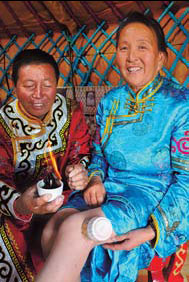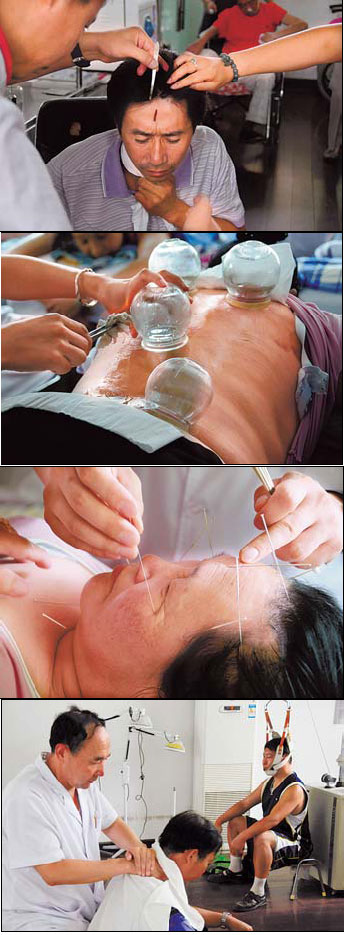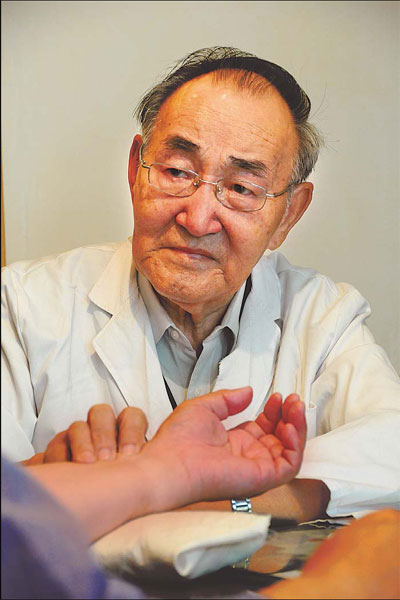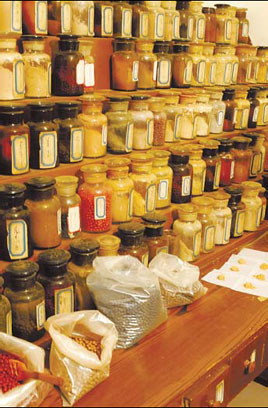Focus
Mongolian medicine recovers
By Cao Li (China Daily)
Updated: 2010-08-25 13:36
 |
Large Medium Small |
|
 Mida (right) has been using a traditional Mongolian therapy to treat her rheumatoid arthritis for decades. Wu Yunsheng / For China Daily |
Demand has peaked but outlook is healthy. Cao Li reports from Hohhot.
Mida no longer herds sheep and cattle on sprawling grasslands; that part of her once-nomadic life is firmly in the past.
Yet, two things will remain the same forever: The recurring pain in her leg and the ancient Mongolian therapy she uses to soothe it.
After lighting a small piece of paper, the 57-year-old placed it in a tea cup and attached it to her left knee.
"It really works for my rheumatoid arthritis," said Mida, who like most ethnic Mongolians uses only her given name. "I only need to do it once a year when the grass seeds germinate in spring."
Mida explained that the traditional treatment had been passed down to her from her mother, who in turn had learned it from her own mother.
"Once upon a time, when medical services were not so easily available, the herdsmen had to be able to cure themselves," she said, smiling.
The flaming tea cup is arguably one of the milder treatments. Other traditional remedies include cutting open fingers to cure intestinal and stomach ailments caused by the summer heat, rubbing white liquor on the breast, back and underarms to cure a fever, and putting fresh sheep innards on the stomach.
"My mother used to always boil raisins, sweet jujube and rock sugar to cure a cold," said Mida, who was 14 when she started shepherding livestock between Hohhot and Baotou in the Inner Mongolia autonomous region.

She and her 62-year-old husband, Huarihu, retired seven years ago when authorities ordered the suspension of grazing on an area of more than 87 million hectares by the end of 2009, part of a nationwide campaign to restore the vegetation on grasslands. The couple is among 400,000 former nomadic herders who have since resettled in towns and cities.
They now live in a home shaped like a traditional Mongolian yurt (a large tent) and rent most of the 90 hectares they were allocated by the government to tourist companies.
Although Mida is holding true to her ancestors' healthcare rituals, some of which have lasted for more than 2,000 years, she knows these ancient ways are in danger of dying out. All of her three children, one of whom lives in Shanghai, know little about her remedies, she said.

Traditional Mongolian medicine remedies, such as (from left to right) blood treatment, cupping, acupuncture and massage have regained popularity in recent years, something the regional government is keen to capitalize on. Photos by Wu Yunsheng / For China Daily |
From humble beginnings
Mongolian traditional medicine originated when herdsmen began using natural ingredients and ancient tools to make ointments to cure injuries or ailments caused by bareback horse riding, fighting or harsh weather.
Historians suggest the system was established in earnest in the 1200s, with some of the therapies later combined with those from ancient Indian, Han Chinese and ethnic Tibetan cultures.
The Mongolian system is based on natural sources, adequate rest and healthy eating. Practitioners say their techniques have proven exceptionally effective in treating cardiovascular diseases, bone injuries, chronic gynecological diseases and hemiplegia (partial paralysis).
Certain remedies are even credited with aiding cancer patients, as they unclog the "white and black veins", energy channels that ethnic Mongolian people believe run through the body.
An hour's drive from Mida's grassland home in Baotou, Bai Shuzhen was relaxing in a waiting room at the Inner Mongolia Zhongmeng Hospital in Hohhot, which specializes in traditional Chinese and ethnic Mongolian medical treatment. She could not contain her excitement as she talked about how her stomachache had disappeared just 60 minutes after undergoing a Mongolian treatment.
"I have tried both Western medicine and traditional Chinese medicine but I find this (ethnic Mongolian remedy) works best for me," said the 69-year-old retired Hohhot primary school teacher. "I never had any idea what Mongolian medicine involved before today; neither did my family, friends or colleagues, even those who are ethnic Mongolian," she said. "All I'd heard was they were ancient remedies used by the nomadic groups," she added.
Also in the waiting room was Jigelatu, who agreed to let China Daily reporters watch his treatment for migraines. After hearing his name called, the 42-year-old was led into another room and seated before a doctor wrapped a towel tightly around his neck and cut open his forehead.
"My headaches feel like a belt tightening around my head," said the businessman as dark red blood drizzled from his head into a small bucket placed between his feet. "Just a few hours after this treatment, the pain will be totally relieved."
The doctor, who stopped the bleeding once the flow slowed to a light drip, said the treatment was to release the heat from the patient's blood.
At the nearby Hohhot Zhongmeng Hospital specializing in traditional Chinese and ethnic Mongolian medicine, 59-year-old Gerilesaihan was receiving a "fire treatment", which involves being massaged with flaming oils. "I heard the hospital here is good and, when I first came in May, I was on crutches and unable to speak," said the herdsman from Bayanhongor in the People's Republic of Mongolia, who has also had acupuncture and cupping therapy. "I regained the ability to speak after the first treatments."
|
 Surongzhabu, 81, who in 2009 was listed among the 30 most renowned doctors of traditional medicine in China by the Ministry of Health, still treats patients every day at his clinic, where waiting times are up to 30 minutes. |

Waiting for relief
As word of mouth about traditional medicine has spread, and as people generally become more health-conscious, practitioners in Hohhot, the regional capital, and on the China-Mongolia border in Erenhot say they have witnessed a steady increase in customers over the past five or so years.
Patients at a clinic run by Surongzhabu, who in 2009 was listed among the 30 most renowned doctors of traditional medicine in China by the Ministry of Health, have to wait in line for about 30 minutes for a ticket to see him.
To build on the popularity of ancient ailments, authorities in Inner Mongolia are now attempting to revive the old system as a way to preserve the region's heritage and complement modern medicine.
"When modern treatments face bottlenecks in dealing with diseases like cancer, cardiovascular disease, diabetes and high blood pressure, people come back to traditional medicine," said Burendalai, deputy dean of Inner Mongolia Medical College's school of Mongolian medicine.
However, practitioners say more must be done if the traditional ways are to be preserved and developed.
Temuqile, who has been practicing for two decades at Hohhot Zhongmeng Hospital, said the revival could be in jeopardy if the authorities do not increase support.
"The resources are not enough to meet the growing demand," said the 42-year-old, as he stood in his clinic surrounded by patients with needles in their faces and glass cups on their backs.
Beds are always in short supply at the Inner Mongolia Hospital. Although it has 500 beds allocated for traditional medicine, it often has more than 600 registered in-patients, according to its vice director, Wulijitegusi.
Help is on the way, though, with 25 hospitals specializing in traditional Chinese and ethnic Mongolian medicine now under construction across the autonomous region.
Among the projects is the International Mongolian Medicine Hospital in Hohhot, which will have room for 700 beds and be able to handle 1,000 outpatients a day. The 18-floor building is scheduled for completion this year.
In addition to new facilities, many also argue that some of remedies need to be updated for the 21st century, albeit carefully. "Doctors used to massage patients with milk cream, which could be considered too smelly now," said Surongzhabu. "Putting fresh sheep skin on a woman's stomach to cure a cold womb (menstrual cramps) is not very practical, either."
Agula, director of Inner Mongolia Medical College's school of Mongolian medicine, agreed and said the system needs to be revised to come in line with international standards and modern technologies.
"Mongolian practitioners that detect illness mostly by touching veins and observing people's faces and complexions need to get to grips with new technologies that are more accurate," he said. "Treatments also must become more sophisticated."
One thing is for sure, added Luhaiwen, director of Erenhot Hospital: "Mongolian medicine cannot survive on its own. It needs to be combined with modern medicine and traditional Chinese medicine to have the best effect."

Traditional Mongolian remedies are made up of natural ingredients, some of which can no longer be found. |
Putting a stain on training
Only about 200 of the more than 2,000 historic Mongolian remedies on record are still in use today. Some have been forgotten, while some cannot be made because of restrictions on the use of animal parts and poisonous ingredients.
Unlike traditional Chinese medicine, ethnic Mongolian medicine is mostly made up of powders and pills, which were easy for nomads to carry.
Although doctors traditionally prescribe combinations that are specific to patients and their problems, Surongzhabu said young practitioners often struggle to learn all the treatments. He expressed disappointment that hardly any of his students had been able to learn all his knowledge.
Orphaned at 14, the 81-year-old medic was adopted by a monk at a lama temple who taught him the craft. "For six years I watched him treating patients, memorizing remedies and making medicine every day," said Surongzhabu, who went on to qualify as a doctor at university and now specializes in cardiovascular disease and cancer.
"I have recorded all my recipes in my books but hardly anyone has bothered to study them seriously," he continued. "For esophagus cancer and stomach cancer, I can elongate patients' life and reduce their pain."
At one time, every doctor could perform every therapy, but that is no longer the case. One expert claimed medical college graduates must study for another five years before they can successfully practice Mongolian medicine, something many are unwilling to do. "There are fewer experienced doctors to carry on the system," said Minggenbayaer, 69, a renowned practitioner specializing in acupuncture.
B. Jigmed, former dean of Inner Mongolia Medical College's school of Mongolian medicine, called for a new college to be set up that educates students in the "strict, old-fashioned way".
"Mongolian medicine is not just a collection of ethnic medicines in China," said the 72-year-old. "It is an important part of medicine for the entire world."
However, with a spike in demand, coupled with the regional government's desire to capitalize on the traditional medicine, there has never been a better time to get a job at a traditional Mongolian medicine hospital.
"All my classmates have already found jobs," said Namula, 27, who graduated from Inner Mongolia College and interns at the Inner Mongolia Zhongmeng Hospital in Hohhot. "Even those who graduated a couple of years ago could not get positions as doctors (at mainstream hospitals)."

